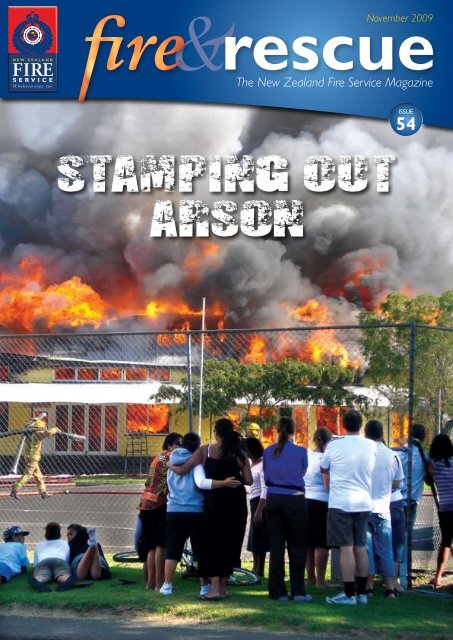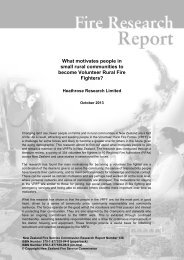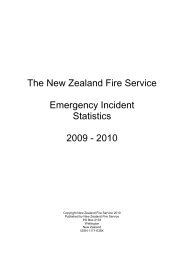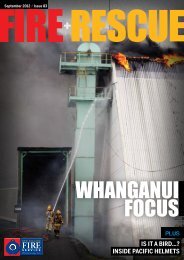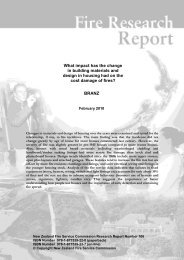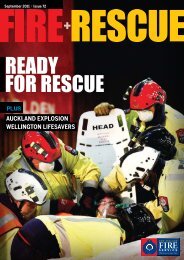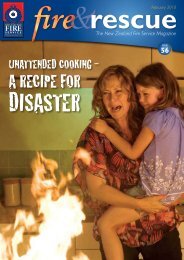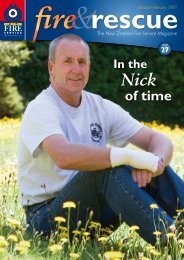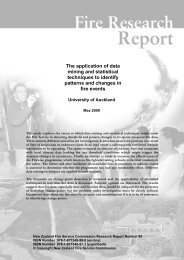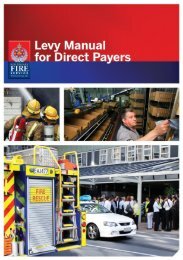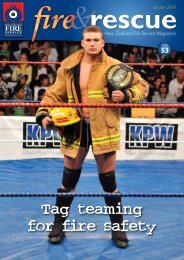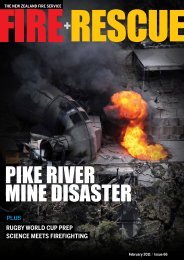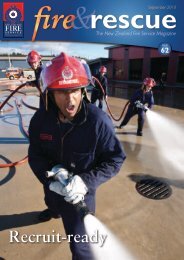Download PDF: Issue 54 - New Zealand Fire Service
Download PDF: Issue 54 - New Zealand Fire Service
Download PDF: Issue 54 - New Zealand Fire Service
You also want an ePaper? Increase the reach of your titles
YUMPU automatically turns print PDFs into web optimized ePapers that Google loves.
November 2009<br />
The <strong>New</strong> <strong>Zealand</strong> <strong>Fire</strong> <strong>Service</strong> Magazine<br />
Stamping out<br />
arson<br />
ISSUE<br />
<strong>54</strong>
November 2009<br />
<strong>Issue</strong> No. <strong>54</strong><br />
<strong>Fire</strong> & Rescue is the flagship<br />
publication of the <strong>New</strong> <strong>Zealand</strong><br />
<strong>Fire</strong> <strong>Service</strong>.<br />
It is produced by Media,<br />
Promotions and Communications,<br />
National Headquarters,<br />
Level 9, 80 The Terrace, Wellington.<br />
Front cover: The community looks on at<br />
the results of arson at a Moerewa school<br />
in Northland. Photo: Rickie-Lee Russ.<br />
Back cover: It’s tougher than it looks,<br />
Tony Dench of Havelock North takes the<br />
determined approach to the Australasian<br />
<strong>Fire</strong>fighters Championship in Rotorua.<br />
Contributions to <strong>Fire</strong> & Rescue<br />
We welcome ideas for articles, news<br />
and events that would be of interest to<br />
other <strong>Fire</strong> <strong>Service</strong> staff and volunteers.<br />
Draft articles and photos (pictures<br />
need to be at least 1MB) can be<br />
emailed to fire.rescue@fire.org.nz or<br />
contact the editor Karlum Lattimore<br />
on 04 496 3702.<br />
Post written material and photos,<br />
or photo CDs to:<br />
<strong>Fire</strong> & Rescue magazine,<br />
PO Box 2133, Wellington.<br />
(These will be returned on request)<br />
<strong>Fire</strong> & Rescue is online at:<br />
www.fire.org.nz<br />
ISSN: 1176-6670<br />
All material in <strong>Fire</strong> & Rescue magazine is<br />
copyrighted and may not be reproduced<br />
without the permission of the editor.<br />
4<br />
10<br />
7 8<br />
<strong>New</strong> Technology Replacement for the radio network ...........................................3<br />
Arson Damping down arson ........................................................................4<br />
What’s <strong>New</strong> Mount Roskill <strong>Fire</strong> Station ................................................................6<br />
<strong>Fire</strong> Safety Keeping their community safe ......................................................7<br />
The Challenge We are the champions .....................................................................8<br />
Conference Notes Encouraging a team approach to fire safety ....................10<br />
The holistic handling of false alarms ......................................11<br />
Hoarders at risk in a fire ..............................................................12<br />
Reducing Risk P manufacturers pose danger to firefighters .....................13<br />
<strong>Fire</strong>works Caught up in the Big Bang ..........................................................14<br />
Helping Others Making a difference .........................................................................16<br />
People A couple of minutes with... Paula Beever .............................18<br />
Notices and <strong>New</strong>s Sports notices .......................................................................................19<br />
2010 UFBA Annual Conference registration<br />
now open ...............................................................................................19<br />
Fuel injection for volunteers .........................................................19<br />
14<br />
16
Replacement for<br />
the radio network<br />
Wellington City firefighter Sam Fairley<br />
tries out a digital radio prototype.<br />
Early next year, Wellington <strong>Fire</strong> <strong>Service</strong> staff will be the first to begin using new digital<br />
radio technology to replace their analogue system, following a similar geographic<br />
roll out plan already underway by Police.<br />
The <strong>Fire</strong> <strong>Service</strong> will share the Police<br />
digital radio network in the same way it<br />
has been sharing the analogue network.<br />
Over time, it’s anticipated other critical<br />
emergency services and support agencies<br />
could join the network.<br />
Police have been using the new digital<br />
radio technology in Wellington since July<br />
this year and expect their rollout into the<br />
Auckland and Canterbury regions to be<br />
completed by December 2010 – in advance<br />
of the Rugby World Cup. The network<br />
is expected to be nationwide in 2014<br />
(subject to government funding).<br />
Project Manager Dave Watson says<br />
“An APCO P25 system is being used,<br />
which is a standard based, ‘open’ system<br />
specifically designed for public safety and<br />
emergency services use.<br />
“The system can operate in conventional<br />
or trunked modes. Police have rolled out<br />
a trunked network in Wellington, with<br />
better voice clarity and secure encryption<br />
– which means their radio comms can’t<br />
be listened to via scanners.<br />
“For us, the new system will see status<br />
messages (selcall) removed from the<br />
voice traffic channel, so there will be<br />
no more distracting bleeps.”<br />
Dave says the channels (talk groups)<br />
are allocated per user group, so the<br />
<strong>Fire</strong> <strong>Service</strong> will have its own talk<br />
groups.<br />
“Coverage is expected to be similar<br />
to what we have currently and in<br />
those areas where digital coverage<br />
is not yet complete, we will use<br />
vehicles with both analogue and<br />
digital radio systems,” he said.<br />
More details on the digital<br />
network and how the system<br />
is operated will be widely<br />
distributed as it rolls out.<br />
<strong>New</strong> Technology<br />
The <strong>New</strong> <strong>Zealand</strong> <strong>Fire</strong> <strong>Service</strong> Magazine November 2009<br />
3
Arson<br />
Damping down arson<br />
Around quarter of a billion dollars worth of property has been lost to arson in<br />
<strong>New</strong> <strong>Zealand</strong> over the past seven years.<br />
Each year, police investigate more than 2,000 arson offences (26<strong>54</strong> in 2008),<br />
three quarters of which are carried out by people under the age of 21.<br />
Around six per cent of all structure fires are started by arsonists.<br />
Deliberately lit fires cause millions of dollars worth of<br />
damage to homes, schools and businesses each year.<br />
The <strong>Fire</strong> <strong>Service</strong> is working with Police and other<br />
government and community agencies on a joint response<br />
to this threat to our community.<br />
In mid November, the <strong>Fire</strong> <strong>Service</strong> hosted the first<br />
National Arson Reduction Forum to promote improved<br />
coordination and collaboration of arson reduction<br />
initiatives in our communities. Those attending the<br />
Wellington meeting included representatives from<br />
Police, <strong>Fire</strong>, Ministry of Education, insurers, psychologists<br />
and others.<br />
4 <strong>Issue</strong> No. <strong>54</strong><br />
<strong>Issue</strong>s that were discussed included domestic arson fraud,<br />
the costs of arson, offender profiling, improved intelligence<br />
systems and how to work together to prevent arson and<br />
catch those who deliberately light fires.<br />
Peter Wilding, <strong>Fire</strong> <strong>Service</strong> Manager of <strong>Fire</strong> Investigation<br />
and Arson Reduction, says “<strong>New</strong> <strong>Zealand</strong> leads the world<br />
in terms of its work with child firelighters. However our<br />
national arson statistics shows there’s still a lot of work<br />
to do”.<br />
Peter has studied arson reduction efforts internationally<br />
and says “There is overwhelming evidence to indicate
that the most effective arson reduction<br />
projects occur when government<br />
agencies, businesses and the community<br />
work together”.<br />
Some of the methods for ramping<br />
up the war against arson that were<br />
discussed at the forum included:<br />
new data analysis techniques, cuttingedge<br />
arson detection equipment,<br />
collaborative working agreements<br />
with the Police and the NZ Insurance<br />
Council, and web based ‘toolkits’ to<br />
provide guidance for reducing and<br />
dealing with arson.<br />
Peter says “It’s vital that we work<br />
together at scenes, share gathered<br />
intelligence, utilise the advantages of<br />
new technology and promote joint<br />
training between our people to ensure<br />
<strong>New</strong> <strong>Zealand</strong> communities are made<br />
as safe as possible from arson.”<br />
The <strong>New</strong> <strong>Zealand</strong> <strong>Fire</strong> <strong>Service</strong> Magazine<br />
Faip – 98 per cent success rate<br />
Groundbreaking research funded by the <strong>Fire</strong> <strong>Service</strong> Commission shows<br />
that our <strong>Fire</strong> <strong>Service</strong> education programme for young fire-setters has a<br />
98 per cent success rate.<br />
The study examined the criminal records of 200 young people who went<br />
through the <strong>Fire</strong> <strong>Service</strong> education programme for young fire-setters.<br />
It showed that only two per cent went on to commit further arsons over<br />
the following 10 years. It also showed that parents, professionals and<br />
participants felt the programme was helpful in raising awareness about the<br />
danger and consequences of fire.<br />
<strong>Fire</strong> <strong>Service</strong> manager of FAIP Peter Wilding said “This study confirms<br />
the incredible effectiveness of FAIP in helping children overcome firelighting<br />
behaviour.”<br />
Lead researcher and clinical psychologist Dr Ian Lambie said “The young<br />
offenders almost all had serious anti-social behaviour and many came<br />
from dysfunctional and multi-problem families. Of the 200 in the study,<br />
over a dozen were imprisoned at some point over the 10-year period and<br />
55 per cent went on to commit offences other than arson”.<br />
“It appears that their fire-setting was not as persistent and prevalent as<br />
their other offending. However this is very likely due to the positive impact<br />
that the FAIP education had on reducing fire-setting. It might be that<br />
some young people also grow out of fire-setting and replace it with other<br />
criminal behaviour. Or it could be a combination of the two – we need to<br />
do more research to find out,” he said.<br />
“What is clear from this recent research is that many fire-setters are at high<br />
risk of future criminal offending so we need to build on our multi-agency,<br />
collaborative approach to address their needs.”<br />
Peter Wilding is also concerned by the high levels of other offending.<br />
“It may be useful to examine whether it would be viable to expand the<br />
programme to address other anti-social behaviours,” he said.<br />
November 2009<br />
Arson<br />
A youngster demonstrates<br />
the fascination with fire.<br />
5
What’s <strong>New</strong><br />
Mount Roskill <strong>Fire</strong> Station<br />
Staff at the new Mount Roskill fire station are happy to show off their new surroundings –<br />
and have been asked to do so by passers-by.<br />
The station was opened by the Prime Minister in September<br />
and replaces the 82 year old former station in Mt Albert Road.<br />
The new station has an urban design theme which is<br />
environmentally friendly with energy saving lighting, heat<br />
efficiency insulation and new non-slip flooring in both the<br />
appliance bay and gymnasium.<br />
As firefighter Ashton Wessels put it “The old station was very<br />
cold, run down and tired. We are really pleased with the new<br />
station – it’s warm and has a friendly feel.<br />
“It’s totally different. We have had a few members of the public<br />
knock on the door and ask for a look round and we have also<br />
picked up some new schools who have brought the children<br />
over for a visit.”<br />
The building has many environmentally sustainable design<br />
features, including: solar water heating, rainwater harvesting,<br />
and great insulation.<br />
Breaking news...<br />
The Kapiti <strong>Fire</strong> Station at Paraparaumu has just won a national<br />
Master Builder Award.<br />
The station, built by Armstrong Downes Limited, was chosen as<br />
the National Winner, Industrial and Infrastructure Project in the<br />
Registered Master Builder 2009 Commercial Project Awards.<br />
The fire station was opened earlier this year and won the award<br />
largely because of its use of smart and sustainable technology<br />
and building practices. Pictures by Eryn Wilson and Paul Startin.<br />
6 <strong>Issue</strong> No. <strong>54</strong>
Keeping their community safe<br />
Volunteers from the Waipara Volunteer <strong>Fire</strong> Brigade in North Canterbury recently visited<br />
all 100 homes in their urban area to install smoke alarms and discuss fire safety.<br />
Simon East talks <strong>Fire</strong>wise with the kids and screws in another smoke alarm.<br />
The initiative is now being extended via a partnership<br />
with rural volunteer fire forces to a further 500 homes<br />
in the outlying district.<br />
The campaign has been spearheaded by Senior <strong>Fire</strong>fighter<br />
Simon East who says “We publicised the campaign<br />
through local newspapers and made the visits on our<br />
training night. We followed up the next week to mop up<br />
the houses we didn’t visit the week before. Then we met<br />
up with the rural fire groups on their training night<br />
to give them some instruction – both in smoke alarm<br />
installation and also general fire safety messaging”.<br />
The week before, the brigade along with Flint and Amber,<br />
spent the weekend at a local vintage machinery festival.<br />
“People at the show really identified with the message<br />
we were trying to get across which helped make our<br />
campaign in the local homes much more effective. It’s a<br />
case of reiterating simple messages over time.”<br />
His advice to other volunteer brigades is to work in<br />
pairs. “Any more people and it gets a little intimidating,<br />
The <strong>New</strong> <strong>Zealand</strong> <strong>Fire</strong> <strong>Service</strong> Magazine<br />
<strong>Fire</strong> Safety<br />
and visiting on your own means you’re too busy to do<br />
the fire safety messaging.”<br />
“Get down to kids’ level. It’s always important with kids<br />
to communicate with them without being patronising –<br />
you’re more likely to get the message across. Also keep<br />
it simple – if we can leave a home with a four year old<br />
able to repeat ‘Get down, get low, get out’ we’ve done<br />
our job.”<br />
Simon was impressed by how well children engaged with<br />
the fire safety message. “It seems <strong>Fire</strong>wise is working and<br />
the message is getting out there. However, there were<br />
a lot of properties where batteries were missing from<br />
smoke alarms.”<br />
The Waipara volunteers also met with several households<br />
that included hearing-impaired people who didn’t realise<br />
they could get special smoke alarms.<br />
The fire safety campaign was funded by the William<br />
Hanna Fund which is administered by national headquarters.<br />
November 2009<br />
7
The Challenge<br />
We are the champions<br />
Carterton has done it again. After earning the title of 2009 UFBA National Waterway<br />
Champion in Queenstown earlier this year, the well-practised team from the Wairarapa<br />
has gone on to take the Australasian <strong>Fire</strong>fighters Championship, held in Rotorua on<br />
17 and 18 October.<br />
By Christa Lawlor<br />
The top teams from six Australian states and <strong>New</strong> <strong>Zealand</strong><br />
competed in heavy rainfalls that came and went<br />
throughout the weekend, causing poor conditions on the<br />
grounds. But the wet weather didn’t seem to faze the eight<br />
teams representing <strong>New</strong> <strong>Zealand</strong>.<br />
Remaining in the driver’s seat for most of the<br />
Championship, Carterton earned 174 points overall and<br />
won six of 10 events along the way. <strong>New</strong> <strong>Zealand</strong>’s<br />
success didn’t stop there. Silverdale, Kaitangata, and the<br />
composite team from Maungaturoto and Havelock North<br />
finished fourth, fifth and sixth, respectively.<br />
And the winners are...<br />
Carterton – (from left to right)<br />
Bottom row: Blaine Smith, James Rodger.<br />
Middle row: Michael Hicks,<br />
Michael Wakefield.<br />
Top row: Wayne Robinson,<br />
Vaea Peterson,<br />
Gordon Taylor (coach).<br />
8 <strong>Issue</strong> No. <strong>54</strong><br />
Mossburn and Havelock North’s four-person team tied<br />
for seventh; the composite team from Tairua and Te Aroha<br />
placed eleventh. Rangiora tied for sixteenth place.<br />
The eight teams representing <strong>New</strong> <strong>Zealand</strong> were chosen<br />
by the UFBA based on their performances at the<br />
Nationals. “Our teams are passionate about these<br />
competitions and have put in countless hours of practice<br />
to get to the Australasian <strong>Fire</strong>fighters Championship,”<br />
said UFBA CEO George Verry. “They dedicate so much<br />
time to protecting their communities and then even more<br />
time to training for these competitions. The <strong>New</strong> <strong>Zealand</strong><br />
teams should be very proud of their efforts.”
Above: And they’re<br />
racing... Kaitangata’s<br />
Greg Peoples,<br />
Kevin Sutton and<br />
Paul Williams.<br />
It was an exciting<br />
weekend of firsts<br />
The United <strong>Fire</strong> Brigades’ Association (UFBA), with<br />
support from the <strong>New</strong> <strong>Zealand</strong> <strong>Fire</strong> <strong>Service</strong>, hosted the<br />
event for the first time on this side of the Tasman.<br />
And in another first, the sought-after Perpetual Trophy<br />
will be held by <strong>New</strong> <strong>Zealand</strong>. Appropriately, Dame<br />
Margaret Bazley, Chairperson of the NZFS Commission<br />
and a resident of Carterton, presented the trophy to<br />
her home-town brigade alongside UFBA President<br />
Lex Calder.<br />
It was also the first time the event reached its 30 team<br />
limit and the first year that the competition adopted<br />
the brand “Australasian <strong>Fire</strong>fighters Championship”.<br />
Although <strong>New</strong> <strong>Zealand</strong> teams have competed in it since<br />
its inception in 2003, it was previously named “National<br />
<strong>Fire</strong>fighters Championship”.<br />
Below: (from left) Silverdale’s Don McErlich,<br />
Adrian Rice and Shanan Fraser haul hose.<br />
National Championship Report Top 10<br />
The Challenge<br />
Photos: Grant Harper<br />
Left: Te Aroha’s<br />
Rawiri White gets<br />
a steadying hand<br />
from an official.<br />
Order Brigade Points<br />
1 Carterton (NZ) 174<br />
2 Nowra (NSW) 117<br />
3 Melbourne (VIC) 87<br />
4 Silverdale (NZ) 86<br />
5 Kaitangata (NZ) 76<br />
6 Maungaturoto/Havelock North (NZ) 72<br />
7 Dandenong (VIC) 70<br />
7 Mossburn (NZ) 70<br />
7 Havelock North (NZ) 70<br />
10 Lakes Entrance (VIC) 64<br />
Full results at: www.firefighterchampionships.com.au<br />
The <strong>New</strong> <strong>Zealand</strong> <strong>Fire</strong> <strong>Service</strong> Magazine November 2009<br />
9
Conference Notes<br />
Encouraging a team<br />
approach to fire safety<br />
A core <strong>Fire</strong> <strong>Service</strong> goal is to actively promote and coordinate fire safety in <strong>New</strong> <strong>Zealand</strong>.<br />
To support this, a large part of our strategy focuses on fire risk management.<br />
All staff, not just those in <strong>Fire</strong> Safety, have a part to play<br />
in helping <strong>New</strong> <strong>Zealand</strong>ers become more fire-safe.<br />
Recently members of the National Community Safety<br />
Group headed out into the regions to discuss the progress<br />
that’s been made to introduce the fire risk management<br />
approach to their work and gather feedback.<br />
Alan Merry, Principal Advisor <strong>Fire</strong> Risk Management,<br />
headed up the visiting team and came back from the first<br />
round of discussions, full of enthusiasm and ideas.<br />
He told those at the <strong>Fire</strong> Risk Management conference<br />
“we had a lot to talk about, and there was some terrific<br />
feedback which gave us insights into the challenges and<br />
Alan Merry talks risk reduction<br />
with a Warehouse representative.<br />
10 <strong>Issue</strong> No. <strong>54</strong><br />
successes being experienced by staff around the county.<br />
Invitations were sent to a wide range of staff for each of<br />
the workshops held in the regions and we still have two<br />
workshops to go in Eastern and Northland.”<br />
Some of the feedback covered problems with training in<br />
the fire risk management material and messages. There<br />
are also some inconsistencies in the way relevant<br />
legislation is being interpreted.<br />
“We also had a lot of interest from staff wanting to take<br />
part in national initiatives and project groups and also<br />
picked up some terrific ideas from people who had been<br />
incorporating fire risk management in their work.”<br />
A full report of the results of the workshops will be<br />
written up over the next month or so and then staff<br />
from outside of NHQ will be brought in to help determine<br />
the next steps.
The holistic handling<br />
of false alarms<br />
The Christchurch method for reducing the number of call outs to false alarms was<br />
showcased at the recent <strong>Fire</strong> Risk Management Conference.<br />
Dan Coward, Area Manager Christchurch Metro, said in<br />
2007 false alarms made up a considerable percentage of<br />
total incidents attended – with 10 per cent coming from<br />
a relatively small number of buildings.<br />
“We set up a team of four people, made up of a rep from<br />
each watch at the city station, who targeted false alarms.<br />
We wanted to reduce the number of incidents attended.<br />
They met with building owners and alarm agents, and<br />
together addressed the activations and influenced the<br />
building owners to make changes. The team also<br />
established relationships with alarm companies so they<br />
could support the changes.”<br />
The <strong>New</strong> <strong>Zealand</strong> <strong>Fire</strong> <strong>Service</strong> Magazine<br />
Conference Notes<br />
Action included:<br />
• Met with alarm companies and explained the cost<br />
to the organisation and company for <strong>Fire</strong> <strong>Service</strong> to<br />
continually attend false alarms.<br />
• Helped alarm companies to see the potential earnings<br />
from upgrading or increasing the maintenance of<br />
faulty or sensitive systems.<br />
• Met with school Boards of Trustees to address false<br />
alarms, and also to introduce <strong>Fire</strong>wise and FAIP where<br />
applicable.<br />
• Met with building owners to ensure they understood<br />
and owned the issue.<br />
• Discussed our plans with the territorial authority and<br />
the potential impact on the council as building owners<br />
began making changes to alarm systems.<br />
“We have now met with the general managers of alarm<br />
companies providing services to the buildings that have<br />
high numbers of false alarms to encourage them to help<br />
reduce call outs.<br />
We’ve also met with the building owners, who are now<br />
investing in upgrading systems or changing processes.<br />
Attitudes towards false alarms are also changing.”<br />
Dan says as a result of the work the Metro team has been<br />
doing there is now a greater focus on building-related fire<br />
risk management and a greater understanding of the<br />
role crews have when they attend a false alarm. They can<br />
see how it can help to have a<br />
relationship with the alarm agent<br />
and the others involved.<br />
“The work has been led by a<br />
small group but this approach is<br />
now well-supported by the crews<br />
in the district which is fantastic,”<br />
he said.<br />
November 2009<br />
11
Conference Notes<br />
Hoarders at risk in a fire<br />
People who hoard huge collections of ‘stuff’<br />
in their homes may be more at risk of dying<br />
if a fire breaks out.<br />
In her presentation to the conference in Rotorua,<br />
Director of <strong>Fire</strong> Risk Management Dr. Paula Beever<br />
highlighted a recent Australian study that looked at<br />
hoarding from a fire risk perspective.<br />
Hoarding is described as the collection of (and failure to<br />
discard) large quantities of objects to the point where<br />
storage impairs basic living activities.<br />
It is a growing problem and seems to typically involve<br />
elderly people.<br />
This study, sponsored by the Melbourne Metropolitan<br />
<strong>Fire</strong> Brigade, was carried out by Bachelor of Science<br />
students from an American university. They looked<br />
at ten years of Melbourne fire incident data and identified<br />
48 hoarding fire incidents. These accounted for<br />
0.25 per cent of all residential fires in that period but<br />
made up 24 per cent of preventable fire fatalities.<br />
Hoarding fires, which typically involved elderly men,<br />
use more firefighting resources than the average<br />
residential fire.<br />
“There are often narrow internal pathways and blocked<br />
exits which make it difficult for people to get out and<br />
also make it hard for firefighters to get in to rescue them<br />
and attack the fire,” said Paula.<br />
A hoarder’s basement.<br />
One in four people killed in accidental house fires in<br />
Melbourne since 2000 has been a “compulsive hoarder”.<br />
To reduce the risk, the study recommended that steps be<br />
taken to improve communication among government<br />
agencies and community care services to provide the swift<br />
removal of risks and access to treatment programmes for<br />
those affected by hoarding behaviour.<br />
In addition, public education about hoarding could<br />
increase referrals to treatment programmes and help<br />
reduce the risks posed by hoarding.<br />
Full details of the study can be found at:<br />
http://web.cs.wpi.edu/~rek/Projects/MFB_D09.pdf<br />
Images from A Hoarder’s Clutter Index – one of the self-assessment tools used by psychologists and others to help identify hoarders.<br />
12 <strong>Issue</strong> No. <strong>54</strong>
p manufacturers pose<br />
danger to firefighters<br />
<strong>Fire</strong> Safety Officers and firefighters are warned<br />
of the danger posed by a new methamphetamine<br />
manufacturing method.<br />
The process has been colloquially referred<br />
to as the ‘shake ‘n’ bake’ or ‘one pot’<br />
method.<br />
An NZFS Safety Notice describes the ‘one<br />
pot’ method, in which methamphetamine<br />
‘cooks’ use a single, sealed container, which<br />
is generally flipped upside-down to cause<br />
the reaction needed to turn several toxic<br />
ingredients into methamphetamine.<br />
This method is very dangerous. The chemical<br />
reaction inside the container (which can be<br />
anything from a fuel canister to a drink<br />
bottle) causes extremely high pressure to<br />
build up after the shaking and becomes<br />
very volatile.<br />
The ‘one pot’ method can be used in fixed<br />
locations or in moving vehicles. In the case<br />
of moving vehicles, the manufacturer<br />
generally drives around while the meth<br />
is being made, and when the process is<br />
completed 30 to 40 minutes later, they throw<br />
the used container filled with toxic chemical<br />
residue out of the window. The remnants of<br />
the chemicals that remain in the container<br />
are generally a muddy brown colour.<br />
The containers can test positive for<br />
anhydrous ammonia and, under pressure,<br />
can result in explosions and inhalation<br />
hazards.<br />
<strong>Fire</strong>fighters should be wary of containers<br />
found at motor vehicle accidents or<br />
property fires. If picked up and shaken,<br />
the contents may react causing an explosion<br />
or inhalation hazard.<br />
In cases where the ‘shake ‘n’ bake’ method<br />
is suspected or identified firefighters should<br />
contact the police for advice before taking<br />
further action, as with any suspected or<br />
identified clandestine laboratory.<br />
Reducing Risk<br />
The <strong>New</strong> <strong>Zealand</strong> <strong>Fire</strong> <strong>Service</strong> Magazine November 2009<br />
13
<strong>Fire</strong>works<br />
Whakatane’s planned<br />
40-minute fireworks display<br />
went off in just 40 seconds.<br />
Guy Fawkes night itself was relatively<br />
quiet according to Communication<br />
Centre managers. However things<br />
were a little livelier the following<br />
Saturday and we must make special<br />
mention of the Whakatane 40-second<br />
spectacular.<br />
Whakatane Rural Volunteer <strong>Fire</strong><br />
Force chief Bill Wycherley was there<br />
with his crew, as he has been for the<br />
last five years.<br />
“We take down the rural fire<br />
appliance, a smoke chaser, and half<br />
a dozen or so interested volunteers<br />
to help sandbag the launchers and<br />
so on. Then we just stand back while<br />
the show goes on. We’ve only had<br />
one spot fire in the past and it was<br />
just about the size of a dinner plate.”<br />
“So this year, we got everything<br />
ready and about a minute before<br />
9pm the fireworks were lit by the<br />
pyro technician with a gadget that<br />
malfunctioned and sent out a small<br />
shower of sparks.<br />
14 <strong>Issue</strong> No. <strong>54</strong><br />
“Ten seconds later there’s an<br />
explosion in the box where the<br />
main cache was held and all hell<br />
breaks loose – the whole lot went off<br />
at once. My truck was about four<br />
metres away and we dived out of it<br />
and tried to get behind a wheel. There<br />
was stuff coming over the top, round<br />
the sides, underneath, burning paper<br />
raining down. It was a frightening<br />
experience. I had ear muffs on but it<br />
was unbelievable; huge thuds and<br />
explosions. We had to dodge all the<br />
flying stuff which was coming from<br />
every which way,” he said.<br />
Bill says it was every man for himself<br />
and the 40 seconds felt like it must<br />
have done during a World War II<br />
blitz.<br />
“We waited it out, poked our heads<br />
up when it went quiet and looked<br />
around at the 50 or more spot fires<br />
that were going. The little island in<br />
the river was also on fire. We did a<br />
quick head count to make sure<br />
Photo: Robert Hepple<br />
Caught up in the Big Bang<br />
The number of call outs to Guy Fawkes-related incidents were down again this year following<br />
the 2007 restriction on the sale of works and a growth in support for public events.<br />
everyone was OK and then just dealt<br />
to fires with the help of the volunteer<br />
brigade’s portable pump. Everyone<br />
was OK, just one minor burn and a<br />
couple of scratches.”<br />
CFO Ken Clarke was home watching<br />
the Canterbury v Wellington rugby<br />
when he got called out.<br />
“It went off, in a big hurry. Set fire<br />
to the vegetation, toetoe and trees –<br />
sky rockets were going horizontal,<br />
vertical every angle you could<br />
think of. Guys jumping for cover and<br />
all sorts.”<br />
“We turned up with two trucks and a<br />
van and pretty much just watched it<br />
all before going home about an hour<br />
later. There wasn’t much we could<br />
do and the Rural guys had it under<br />
control,” he said.<br />
Bill says the team finished up about<br />
1am and then headed back out over<br />
the next few days to damp down a<br />
few hot spots.
The history of change<br />
In 2004 the <strong>Fire</strong> <strong>Service</strong> National<br />
Commander called for public debate on<br />
the banning of private sales of fireworks<br />
and a year later the SPCA began its<br />
campaign for a total ban.<br />
Prior to Guy Fawkes night in 2005,<br />
there was a spate of fireworks-related<br />
fires caused mainly by irresponsible use<br />
by young people.<br />
The <strong>Fire</strong> <strong>Service</strong> announced it was in<br />
favour of a ban against fireworks sales<br />
to the public, with sales allowed only to<br />
approved handlers for public displays.<br />
It backed this with a call for research<br />
on the views of <strong>New</strong> <strong>Zealand</strong>ers. Almost<br />
half thought fireworks should not be<br />
available for sale. There was then a<br />
widespread debate with strong public<br />
support for a change.<br />
In 2007 the <strong>Fire</strong>works Regulations were<br />
amended to raise the age of purchase<br />
from 14 to 18; fireworks could only be<br />
sold on the four days up to and including<br />
4 November; sales of sparklers were<br />
restricted so there could be no more<br />
than 50 in one pack.<br />
Guy Fawkes in 2007 was the quietest in<br />
<strong>Fire</strong> <strong>Service</strong> records, with the lowest<br />
number of call outs since records began<br />
in 1996. The following two years have<br />
also seen significantly fewer fireworksrelated<br />
incidents and the <strong>Fire</strong> <strong>Service</strong><br />
continues to monitor the public’s<br />
response.<br />
Rural fire dealt with this aftermath in Whakatane. Photo: Robert Hepple.<br />
The <strong>New</strong> <strong>Zealand</strong> <strong>Fire</strong> <strong>Service</strong> Magazine<br />
<strong>Fire</strong>works<br />
Public events are becoming increasingly popular and it’s estimated over 150,000 people<br />
attended this display on the Wellington waterfront. Photo: Dominion Post.<br />
November 2009<br />
15
Helping Others<br />
16 <strong>Issue</strong> No. <strong>54</strong><br />
Jim Stuart-Black and Ian Pickard –<br />
back at work after their hectic<br />
deployments.<br />
Making a difference<br />
Most <strong>New</strong> <strong>Zealand</strong>ers only<br />
experience an international<br />
disaster via the six o’clock<br />
news. For <strong>Fire</strong> <strong>Service</strong><br />
staff Ian Pickard and<br />
Jim Stuart-Black it can be<br />
a grim but rewarding reality.<br />
Jim and Ian are two of the nine<br />
<strong>New</strong> <strong>Zealand</strong>ers who form part<br />
of the 240-strong international<br />
United Nations Disaster Assessment<br />
and Coordination team (UNDAC).<br />
Members are deployed at the<br />
request of foreign governments to<br />
help with aid coordination, information<br />
management, and impact<br />
assessments.<br />
Recently Jim (<strong>Fire</strong> <strong>Service</strong> National<br />
Manager Special Operations) was<br />
sent to Samoa to help out with the<br />
tsunami relief effort while Ian<br />
(Arapawa <strong>Fire</strong> Region Manager) went<br />
to the Philippines following the<br />
devastation caused by tropical storm<br />
Ketsana and typhoon Palma.<br />
Ian with the San Isidro Village Council for discussions around the help they need.<br />
“It’s come as quite a jolt to see death<br />
and destruction on a massive scale<br />
right in front of you. But it’s fantastic<br />
to be able to see the difference you<br />
can make in a very short time,” said<br />
Ian who spent much of his 16-day<br />
deployment trudging through mud<br />
and floodwaters.<br />
“You can be in an evacuation camp<br />
one day, working out the priority<br />
needs, and see the supplies arrive by<br />
helicopter the next day,” he said.<br />
The days are long and often difficult,<br />
filled with travel by truck, jeep and<br />
helicopter, meetings, and report<br />
writing.<br />
“The first few days you’re lucky if<br />
you get just two or three hours sleep<br />
a night,” said Ian.
Temporary living for<br />
many of the villagers<br />
above the hills of<br />
Lalomanu in Samoa.<br />
Flooding outside the hospital at Pateros City, Manila. An illustration of the wreckage left by the tsunami in Samoa.<br />
Basically, UNDAC advisors work<br />
with local agencies to determine<br />
exactly what is needed following a<br />
disaster and then help put a process<br />
in place to make sure the right help<br />
is distributed fairly and efficiently.<br />
They look at the priorities for health,<br />
food, water, shelter, agricultural<br />
impact, local government infrastructure<br />
and capacity as well as<br />
public and personal safety issues.<br />
Jim, who spent 11 days in Samoa,<br />
says like Ian, he also finds the UN<br />
work incredibly satisfying.<br />
“There were two of us from UNDAC<br />
but we also called in support from<br />
an IT specialist and someone from<br />
the World Food Programme. That’s<br />
the thing about UNDAC – you have<br />
The <strong>New</strong> <strong>Zealand</strong> <strong>Fire</strong> <strong>Service</strong> Magazine<br />
access to support from anyone in the<br />
international aid community.”<br />
Jim says that the UN team generally<br />
tries to strengthen the local effort,<br />
provide guidance and then hand over<br />
to the locals as soon as they are able<br />
to sustain the relief effort.<br />
“The response in Samoa was<br />
phenomenal. The government, aid<br />
groups, matai (local chiefs), NGOs<br />
and all the others involved in the<br />
disaster were very well organised.”<br />
Both men say they have come back<br />
with a strong impression of how<br />
generous people can be under the<br />
most difficult of circumstances.<br />
“The people in these countries have<br />
often lost everything but they still<br />
Promotions<br />
help each other and welcome you<br />
with smiles and offer you whatever<br />
food they have left,” said Ian.<br />
The UN payment for the emergency<br />
management expertise of Ian and Jim<br />
is a princely $1 (US) a year. “That’s a<br />
contractual amount for the UN<br />
insurance coverage,” explained Ian<br />
who admits he’s never declared the<br />
income to the <strong>Fire</strong> <strong>Service</strong>.<br />
Jim and Ian’s advice for those<br />
people wanting to support an<br />
international aid effort is to donate<br />
money – that way you can be sure<br />
it will be spent on what is actually<br />
needed by those who have been<br />
struck by disaster.<br />
November 2009<br />
17
People<br />
A couple of minutes with...<br />
18 <strong>Issue</strong> No. <strong>54</strong><br />
Paula Beever Where<br />
are you stationed?<br />
NHQ in Wellington.<br />
What’s your title?<br />
Director <strong>Fire</strong> Risk Management.<br />
What’s been your progression within the NZFS<br />
over the past 25 years?<br />
Joined 11 years ago as Principal <strong>Fire</strong> Engineer – a new role<br />
at the time, then grew into a succession of other roles.<br />
Family?<br />
Married to Ron, who has three children and five<br />
grandchildren – I do rather like the step-granny bit.<br />
What’s the one thing that sticks in your mind<br />
about the job?<br />
The dedication and enthusiasm of colleagues.<br />
If you could make one change to the <strong>Fire</strong> <strong>Service</strong><br />
what would it be?<br />
To make the change to fully integrate risk management<br />
principles into everything we do.<br />
Your most embarrassing moment on the job?<br />
Can’t think of one – or not one I’m prepared to admit to…<br />
What’s one thing people would be surprised to<br />
learn about you?<br />
Nothing – it’s all on Google: from the time I achieved<br />
in Wellington’s round-the-bays run last year to an article<br />
I wrote on weeds for the Cottage Garden Society!<br />
Favourite book? Pride and Prejudice.<br />
Favourite movie?<br />
Goldfinger – the first film I ever saw on the big screen.<br />
Favourite TV show?<br />
Pie in the Sky – a 1990s UK series I just watched again.<br />
Favourite music group? Rolling Stones.<br />
Favourite sport? Walking in mountains.<br />
Favourite holiday desination? France.<br />
If I wasn’t in the <strong>Fire</strong> <strong>Service</strong>...<br />
I’d be in engineering consultancy.
Sports Notices<br />
7-a-side soccer tournament<br />
28-31 January 2010, Arena Manawatu<br />
Contact: Michael.baillie@fire.org.nz<br />
Ph: 027 2443997<br />
<strong>Fire</strong> <strong>Service</strong> Mountain Bike<br />
Championships<br />
18th & 19th of February 2010<br />
Makara Peak, Wellington<br />
All events are open to members of the NZFS and<br />
their families. The courses have been designed to be<br />
achievable to all riding levels.<br />
Contact: Gareth Hughes, SO Avalon Red Watch<br />
Ph: 027 4089098<br />
2010 <strong>Fire</strong>fighters National Surfing<br />
Championships<br />
15-18 March, Piha<br />
The event is open to all past and present members<br />
and volunteers of the NZ <strong>Fire</strong> <strong>Service</strong> and the National<br />
Rural <strong>Fire</strong> Authority. Entry fee $50 for two divisions,<br />
refreshments and hangi on prize giving night.<br />
Contact: Stephan Sosich<br />
Email: ssosich@xtra.co.nz • Ph: 027 2284085<br />
2010 UFBa annual<br />
Conference registration<br />
now open<br />
The conference will take place in Christchurch<br />
from 26 to 28 February. Don’t miss out…<br />
register before 11 December 2009.<br />
Each UFBA member brigade was sent a conference<br />
registration pack along with voting papers for the<br />
Board election by post. If you plan to attend the<br />
conference, you will need to register by going online<br />
to http://www.ufba.org.nz/events/ and clicking the<br />
registration link. Late registrations will not be<br />
accepted. The complete conference information pack<br />
is also available for download through the website.<br />
Another reminder to brigades: the postal ballot for the<br />
Board election closes on 1 February 2010 at noon.<br />
The <strong>New</strong> <strong>Zealand</strong> <strong>Fire</strong> <strong>Service</strong> Magazine<br />
Notices and <strong>New</strong>s<br />
Fuel injection<br />
for volunteers<br />
BP <strong>New</strong> <strong>Zealand</strong> has donated fuel<br />
vouchers to volunteer organisations<br />
using vehicles to provide essential<br />
services since 2006.<br />
Our 7,500 volunteer firefighters use their own<br />
vehicles to respond to the station whenever there<br />
is an emergency incident in their community,<br />
any time of the day or night. This generosity of<br />
time and money was a significant factor in the<br />
<strong>Fire</strong> <strong>Service</strong> again being one of the lucky recipients<br />
in the Vouchers for Volunteers programme.<br />
The vouchers have been donated to over 400<br />
national, regional and local organisations with<br />
$6000 worth given to brigades throughout the<br />
country to recognise and reward the efforts of<br />
volunteer firefighters.<br />
SO Ralph Francis of <strong>New</strong>lands VFB accepts the fuel vouchers<br />
on behalf of the NZFS from BP <strong>New</strong> <strong>Zealand</strong>’s Managing<br />
Director, Mike McGuinness.<br />
November 2009<br />
19
The <strong>New</strong> <strong>Zealand</strong> <strong>Fire</strong> <strong>Service</strong> Magazine<br />
Published November 2009<br />
By the <strong>New</strong> <strong>Zealand</strong> <strong>Fire</strong> <strong>Service</strong><br />
Media, Promotions & Communications<br />
National Headquarters, Wellington<br />
www.fire.org.nz


